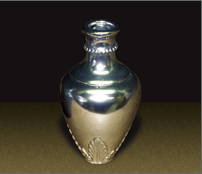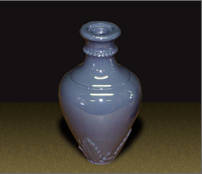

G.J. Nikolas & Co., Inc.
2800 Washington Blvd.
Bellwood, Illinois 60104
Phone: 708-544-0320
Fax: 708-544-9722
E-mail: info@finish1.com
|
|
 |
 |
 |
 |
|
Description
|
|
|
|
|
|
|
|
QuickSilver
is a new coating product line. Its appearance will simulate
a chrome or polished silver finish. It can be applied to
any substrate such as metal, wood, plastic and glass. It
will give a near mirror finish. QuickSilver
is very versatile and can be used on small runs or large
items and does not require special equipment.
|
Suggested Uses:
QuickSilver
can be used in every industry; hardware, automotive, lighting,
trophies, jewelry, fishing lures, statuary, picture frames,
cosmetic containers, architectural metal maintenance and
more.
DOT SPECIFICATIONS: PAINT, 3, Flammable Liquid UN1263,
PGII
|
|
Benefits
|
|
|
|
|
|
|
|
• Near mirror finish.
• Many vehicle types.
• Use with your existing conventional spray equipment
• Airdry or bake depending on vehicle.
• Easy application
|
• Use on small runs
or large items.
• Can be toned or antiqued to match almost any metal
finish.
• Will work on a variety of substrates, metal; plastic;
glass etc.
|
|
Variations
|
|
|
|
|
|
|
|
Nikolas makes four types
of QuickSilver
for various requirements. This sample pack is supplied with
#12594, and #12596.
#12594 QuickSilver AC air dry; should be used over
#12559 Black Epoxy Primer or equivalent.
#12596 QuickSilver AC air dry; will work without
primer on ABS; acrylic and urethane plastic.
#12598 QuickSilver HC Bake bake at 275 degrees F
for 30 minutes. Should be used over a baked basecoat. This
version holds its brightness better than our other versions.
#12600 3.5 QuickSilver AC VOC Compliant version of
#12596 QuickSilver AC.
|
|
|
Sample Pack Contents:
|
|
|
|
#12559 Black Epoxy Primer
PT. A
#12191 Epoxy Hardener PT H Acetone
#12594 QuickSilver AC - For use on metal, over primer
#12596 QuickSilver AC - For use on plastic, no primer required
#11727 Gold Toner RFU
|
QuickSilver
Sample Pack Instructions Full set of MSD Sheets
|
|
Directions
for Use: Base Coat Primer
|
|
|
|
|
|
|
QuickSilver
will metalize well on a variety of basecoats. Basecoats
which will not re-dissolve give the best results. Bakes,
urethanes, and two part epoxies are all suitable. This sample
pack is supplied with a two part epoxy, #12559 Black Epoxy
Part A with its hardener #12191 Epoxy Hardener.
Using a primer as a basecoat for QuickSilver
is important for two reasons. First, it insures the best
adhesion of the QuickSilver
to the substrate. Second, it smoothes any imperfections
that may be present on the substrate such as casting or
polishing marks.
When used on basecoats that will re-dissolve, the metalizing
effect of QuickSilver
is disturbed and subsequently is not as bright. The same
problem occurs when top coating QuickSilver
with clears or toners, and much of the metalizing effect
is muted.
|
|
Directions
for Use: Application
|
|
|
|
|
|
|
Metalizing
with QuickSilver
is accomplished in three steps: Primer Coat; QuickSilver
Metalizing Coat; and clear or toned Topcoat
|
|
For
Plastic Substrates:
|
Plastics:
When applying QuickSilver
to ABS, Acrylic or Urethane, a primer coat is generally
not needed. Care should be taken to remove any mould release
agents prior to application of #12596 QuickSilver to the
surface of the plastic.
|
|
For
Metal Substrates:
|
Primer
Coat: For primer
coat use Nikolas #12559 Black Epoxy Primer. Mix ratio is:
one part #12559 Black Epoxy Primer; one part #12191 Epoxy
Hardener; and one part Acetone. Mix components thoroughly.
Adjust atomizing air to 45 to 50 PSI, and apply. #12559
should appear glossy and wet, but be careful not to flood
as runs and sags will occur. To air dry, allow #12559 Black
Primer to cure overnight before proceeding. To force dry,
flash off 5 minutes then bake at 120 to 140 degrees Fahrenheit
for thirty minutes. Coating is cured after it has fully
cooled.
Metalizing Coat: For
metal substrates use #12594 QuickSilver AC after following
step for primer coat, for plastic substrates use #12596
QuickSilver AC without primer. Mix QuickSilver
thoroughly. QuickSilver
is ready for use and further reduction is not recommended.
Set air pressure between 35 to 40 PSI. Apply one wet coat,
multiple coats will not be as bright. Wet, QuickSilver
will appear dull, but will turn brilliant as it dries. Allow
QuickSilver
coat to set 2 hours before proceeding. To force dry, flash
off 5 minutes and bake between 120 to 140 degrees Fahrenheit
for thirty minutes. Fully cool to room temperature before
proceeding.
Clear or Tone Coat:
Prepare clear lacquer or toner for spraying. Set air pressure
between 45 to 55 PSI. Apply a thin wet coat, and allow coat
to set at least 30 seconds. Apply a final full wet coat
and allow to air dry overnight before packing or force dry
as mentioned in previous steps. Product can be packed 1
hour after cooling. This kit contains #11727 Gold Toner
RFU. #11727 is pre-thinned, no further reduction is required.
Stir well before using.
|
|
Precautions
|
|
|
|
|
|
|
|
Allow sufficient
cure time between coats. Fully cured base coat and QuickSilver
coat will hold the metalizing effect better than if the
steps are rushed.
When applying QuickSilver,
cover the piece in one continuos wet coat. Don't spend too
much time spraying in detailed areas. Because of its low
viscosity QuickSilver
will flow well into tight spots. QuickSilver
will not metalize well if a second QuickSilver
coat is sprayed, so do as good a job as possible in one
pass, and stop spraying. Just stand back and watch it dry.
To achieve any abrasion resistance, QuickSilver
requires a clear or toned topcoat. Some brilliance of the
metalizing will be lost when the topcoat is applied. This
can be minimized by allowing full cure time of base coat
and metalizing coat. Do not spray too heavy when applying
first top coat pass. Allow the coat to flash off at least
30 seconds before applying a full final wet coat.
|
|
Protective
Equipment
|
|
|
|
|
|
|
Eyes:
Safety glasses
Skin: Neoprene rubber gloves
Respiratory: NIOSH approved respirator for organic
vapor.
In case of fire: Use foam, dry chemical, CO2, water
or spray fog.
Grounding: When transferring, fill stem and container
must be grounded and bonded.
CONSULT MSDS PRIOR TO HANDLING.
|
| Safety |
|
|
|
|
|
| |
Keep away from
heat, sparks, and flames. USE WITH
ADEQUATE VENTILATION. Avoid prolonged or repeated
contact with skin. Avoid prolonged breathing of vapor or spray
mist. Do not take internally. KEEP
OUT OF THE REACH OF CHILDREN. Before smoking or
eating and after using, cleanse hands thoroughly. Keep container
closed when not in use.
Effects of Overexposure: Prolonged use may cause mild
irritation to eyes.
Skin Contact: Can cause irritation, may be absorbed
through the skin and cause defatting.
Inhalation: May cause respiratory irritation, dizziness
and drowsiness.
|
| |
These suggestions and data
are based on information we believe to be reliable. They are
offered in good faith, but without guarantee, as conditions
and methods of use of our products are beyond our control.
We recommend that the prospective user determine the suitability
of our materials and suggestions before adopting them on a
commercial scale. |
| |
|
|
|
 |
|
 |








